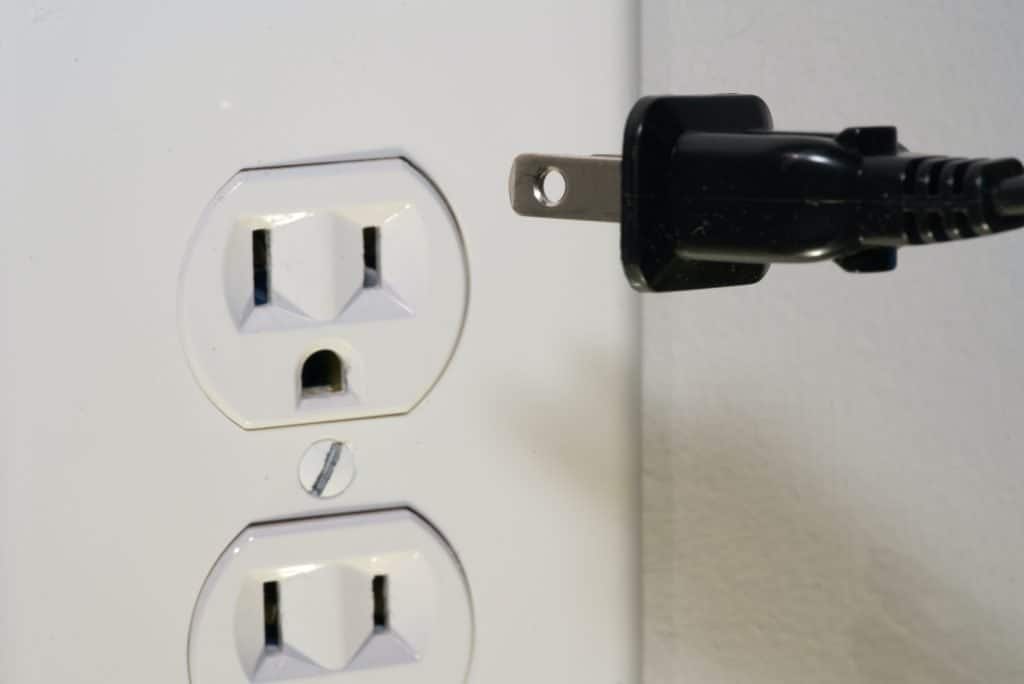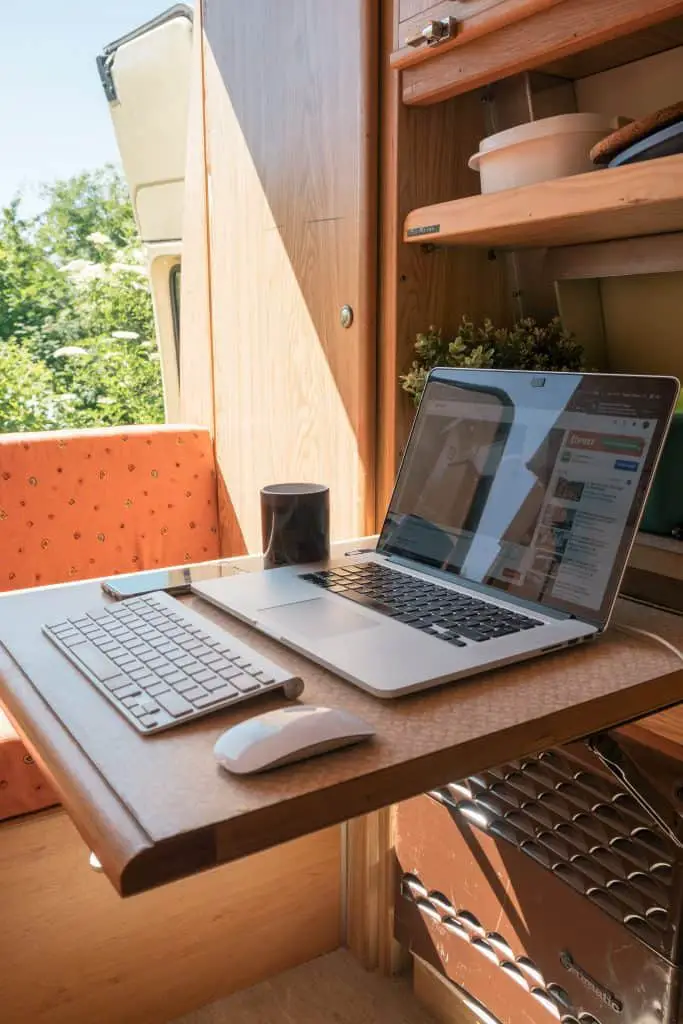There are some electronics in your van life that simply can’t be powered directly from your 12V campervan batteries. These include things like laptops, blenders and microwaves. To power these devices you will need the help of an inverter.
Not everyone with a campervan will need an inverter, but for many it’s an essential piece of kit. Choosing the best power inverter for a camper can be a daunting task and there’s a few important considerations that need to be made before you make that decision.
I don’t use many power hungry devices in my campervan but there are a few items that require the use of an inverter, namely my laptop, drone and camera. During my van upgrades, I set out to find the inverter best suited to my needs.
In this guide I outline everything you need to know in order to make that inverter for camper purchase. I’ve done the hard yards so you don’t have to!
Disclaimer: Some links in this article are affiliate links, which means that if you purchase through them I receive a small commission, at no extra cost to you. This helps cover the cost of running this blog. Thanks for your support!
Campervan Power Inverters at a Glance
Short on time? No problem! The best power inverter I recommend for camper vans is the Renogy 1000w pure sine inverter. Renogy is a reputable brand and this inverter offers the best quality product for an unbeatable price. To discover more about inverters, read on below.
The Science Bit – What is a Power Inverter?
An inverter is a device that converts DC current to AC current. DC current is the type of power coming from your van’s batteries and AC current is the type of power that comes from your wall sockets at home.
When choosing a camper power inverter you need to consider two main factors:
- how much power is required.
- what type of power is required.
Types of Inverters – Sine vs Modified Sine
There are two types of power inverters:
- Pure Sine Wave (PSW)
- Modified Sine Wave (MSW)
Without going into too much technical jargon, suffice to say that pure sine wave (PSW) inverters produce a clean or smooth wave of AC current, similar to what you get from the grid.
Modified sine wave inverters (MSW) produce a stepped or blocked current that merely mimics the wave of AC current. In reality what this means is that some electronics may not work properly with modified sine inverters. It may cause the electronics to run less efficiently through more heat production.
PSW inverters are more expensive, so if you’re on a budget or aren’t planning to use complex or sensitive electronics, then opt for a MSW inverter. However, if you want to ensure your gadgets get pure, clean electricity then get a PSW inverter.
For the price difference I would always recommend choosing a PSW inverter.
Top Tip: Look for inverters that state Pure Sine or True Sine, otherwise they’re probably modified sine

What Size Inverter Do I Need For a Campervan? Factors to Consider
This is the most important decision to make when choosing a camper van inverter and there are a few factors that influence it.
Power inverters are sized by the amount of Watts of AC power that they can produce. They have ratings for peak/surge watts and continuous watts.
Surge watts refer to the maximum amount of power that can be generated in one burst. This power will only last a short time, usually just a few seconds.
Continuous watts, as the name suggests, is the amount of power an inverter can continuously generate. This number is usually displayed in the inverter name.
1. Surge power demands
This is an important factor if you have any appliances that require an initial surge of power, such as a blender or a microwave. (Or as we discovered last spring, washing machines – ahhh it’s a long story!).
Check the surge watt of your desired inverter can match the surge requirement of your appliances. If you’re not sure what your appliances’ surge demands are, just ask our old friend Google for the relevant appliance manual and take it from there.
2. Continuous power demands
To discover how much continuous energy you need, make a list of all the appliances that will require AC power and add up the wattage they use. This is a bit extreme since you likely won’t be using all of these appliances at the same time, but for arguments sake that’s the size inverter you require if you do.
Here are some typical appliance continuous power needs:
- Laptop 200w
- Blender 400w
- Dehumidifier 800w
- Hairdryer 1000w
Top Tip: Again, don’t forget that appliances like blenders and hairdryers will have higher surge demands, so make sure the inverter can handle the surge.
3. Inverter (In)Efficiency
Inverters are not 100 % efficient and will lose some energy when they convert power. Therefore you will need to add around 10-20% to your appliance total.
Note here that bigger is definitely not better due to the increased amount of inefficiency. A lot of power is lost through heat production and this increases with larger power inverters. Larger inverters also increase significantly in cost without seeing any real increase in benefit.
I’m all about low cost and big benefits when it comes to van life. (And life in general!)
But it’s not just what the highest surge requirement is or what the total continuous power will be, along with 10-20% for energy conversion loss. It get’s a little more complicated than that….

4. Battery Capabilities
You also need to know if you have the capacity to power these appliances from your solar set up, namely your batteries. It’s important to buy an inverter that correctly matches the size and type of your battery. This is where many van lifers come unstuck.
Let me explain using the following example.
- A 100ah battery can run a 1000w inverter at full power for 1 hour before it is completely drained. This is calculated through using the following equation:
Inverter watt load/volts = amps per hour
Then:
Battery size/amps per hour = runtime
A 1000 watt inverter / 12v ((typical camper van system) = 83.3 amps. So a 100ah battery should be used to allow for inverter inefficiency.
Then:
100ah battery/83.3 amps per hour = 1.2 hours. Batteries discharge faster when more amps are drawn so this will likely be more like 1 hour.
However, we don’t want our batteries completely drained. If you’ve read my guide to buying campervan leisure batteries, you will know that it’s harmful for batteries to let go of all of their energy at once. We know lead acid batteries should only be discharged to 50% of the maximum before being recharged. (For lithium batteries the depth of discharge is more like 80% and for some AGM batteries it’s more like 70%).
So in this instance, the inverter should only be run for 30 minutes, after which you will start depleting your battery’s lifespan (assuming the batteries aren’t being powered by shore power or topped up by solar energy).
With these four considerations in mind, you can now work out what your power needs are. Can your electrical system support your power needs? If not, something has to give and it could be as simple as never using all of your appliances at once!
Renogy has a new energy calculator feature on their website which does all the calculations and suggests the appropriate products to use. Check out the calculator here!
Related Reading
- Discover the best campervan fridges in this guide
- The Best Campervan Roof Vents In 2023
- Rigid vs flexible solar panels- which is best?

More Factors to Consider When Choosing a Power Inverter For Your Camper
Will you be using hook-ups? (Shore power)
Consider an inverter which has a transfer switch which will power devices from mains hook-up when you’re plugged in and flip to the inverter when you’re running off-grid.
Or you could consider an inverter/charger. These operate as a battery charger when your van is plugged into the mains and a regular inverter when you’re running off the batteries. This is quite handy if you need to supplement your solar setup, for example during winter when daylight hours are limited (at least here in the UK!)
Do you really need a van inverter?
If you only use your van on weekends or small trips do you actually have any appliances which require AC current? Most gadgets come with USB chargers these days which makes inverters somewhat redundant.
Idle consumption
Power inverters actually uses a little power, even when they’re not running so this needs to be factored in.
Safety certification standards
It’s worth considering whether the inverter conforms to recognised safety standards to ensure to it’s completely safe to use. For example ETL or CE.
Brand
As with many things electrical, it’s also worth noting if the inverter is manufactured by a reputable brand or just some random company that’s popped up on Amazon and doesn’t have any reviews yet. Cheap prices can also be a giveaway here.
The Best Campervan Inverters
1. Best Overall – Renogy 1000W Pure Sine Inverter 12V to 240V
- 【POWERFUL DC-AC】1000W continuous, 2000W peak surge during load start-up, 12V to 120VAC pure sine wave with conversion efficiency >90%, reduces conversion loss. Offers high quality waveform with little harmonic distortion. Overload protection for both DC input and AC output to prevent damage to the components and the unit.
- 【SAFE FOR USE】LED indicators for under-voltage and over-voltage protection, over-temperature protection, over-load protection, and short circuit indication. High-speed ventilation fans to help keep the inverter running at a low temperature.
- 【PROTECT YOUR ELECTRONICS】Advanced pure sine wave technology provides quality AC equivalent to grid power which will protect and extend the life of your electronics and appliances. With its quiet and high inductive loads, there are no strange buzzing sounds when your electronics are turned on, and allow them to run smoother, cooler, and quieter.
- 【EASY-TO-USE】 Offers 1 AC Outlets, along with two 2Ft 4AWG Cables and a 9ft Wired Remote. Renogy offer a free return service for you to make you hassle-free.
- 【RELIABLE QUALITY】ETL certification listed. Offers 1-Year material and workmanship warranty. Please feel to to contact us if you need this product's electronic manual or specifications. Customer service team on call 24 hours a day to answer your questions and solve your problems.
This Pure Sine Inverter from Renogy is the best value, highest quality product on the market. Renogy are a reputable brand who make top quality batteries, solar panels and charge controllers amongst other things. You know you’re gonna get a good product and top service when you buy from Renogy.
This inverter offers 1000w continuous power and 2000w surge power, although higher power options are also available. The 2000w inverter is another solid choice for most van lifers. It has a high conversion efficiency of 90%, is ETL listed and is similarly priced to no-named alternatives.
What’s not to love?
Renogy often have big sales on their products making them even better value. The price of this inverter is currently cheaper if you buy directly through Renogy.
2. Best Budget Choice – Yinleader 1000W Pure Sine Inverter 12V to 240V
- Pure Sine Wave:An absolutely pure sine wave power inverter converts 12V DC to 240V AC with LED input voltage display.The inverter has a continuous output power of 1000W,ideally suitable for Journeys, Camping, Tents, Working on the way. If the power of your device is more than 150W, please use a cable to connect it directly to the car battery.
- Advanced Protection Function:Overload / Short Circuit / Over heat / Reverse Polarity / Under or Over Voltage protections.
- High power reserve: 1 x UK socket and 2 x USB ports, your devices can work while you are charging your phone / tablet. It is very suitable for providing pure sine wave for electrical devices such as illumination equipment, laptops, car refrigerators, shavers, cameras ,small drills,etc.
- High quality fan:due to the active, temperature-controlled fan cooling (the fan rotates over 45 ° C), the inverter is very quiet at low loads.
- Package included: A power inverter , 2 x battery cables, 1 x cigarette lighter plug (please use under 150 W). Refrigerator must use battery cables.If there is any problem, please contact us, we provide one year after-sales service.
This pure sine inverter from Yinleader is almost half the price of the Renogy but it only has one socket. Yinleader have been making inverters for 10 years and offer the same protection from overload and high temperature. If you upgrade to the 1500w version you will have two sockets and a greater power output, but the price jumps significantly.
This inverter only weighs 1kg which is much lighter than the Renogy at 3kg, however there is no warranty on offer. If you’re looking for a budget option from an unknown brand then this would be a good option, however, I personally opted for the Renogy, taking peace of mind that I have a top quality product.
3. Best Inverter and Charger in One – Renogy 2000W Pure Sine Inverter Charger
- 【POWERFUL OUTPUT】Delivers continuous power of 2000W and surge power up to 6000W, effortlessly driving your everyday electrical appliances with an impressive conversion efficiency of over 90%.
- 【ELECTRONIC SAFEGUARD】Advanced Pure Sine Wave technology guarantees high-quality AC power equivalent to grid power, safeguarding your household appliances and electronic devices, particularly those sensitive to electrical fluctuations.
- 【COMPREHENSIVE SAFETY FEATURES】Provides comprehensive protection against under-voltage, overvoltage, overload, overheating, and short circuits, ensuring peace of mind and safety for your electrical system.
- 【VERSATILE COMPATIBILITY】Seamlessly compatible with a wide range of battery types including GEL, AGM, SLA, FLD, CAL, and LI, providing powerful connectivity for various energy storage needs.
- 【4-STAGE CHARGING】The Renogy 2000W pure sine wave inverter charger is equipped with a 4-Stage (Bulk stage, Boost stage, Float stage, and Equalization) battery charger, ensuring optimal and automatic charging to reach 100% capacity efficiently.
This hefty beast will provide all the power conversion you need and then some! At 2000W continuous this inverter will be able to run a microwave, heater and charge devices, all at the same time. Plus, with a surge power of 6000W it will cope with the most demanding of power hunger appliances.
The charger element of this device also ensures that batteries are charged and maintained whilst connected to shore power (hook ups). Charging is cleverly optimised to get the best battery life.
However, there is a big price to pay for this dual prowess and that comes predominantly with the price tag but also with the size and weight. This inverter/charger is a massive 23.2kg in weight and half a meter in length, so ensure you have enough space before investing in an inverter charger.
Renogy often have big sales on their products making them even better value. The price of this inverter/charger is currently cheaper if you buy directly through Renogy.
Campervan Power Inverter FAQs
Are power inverters noisy? Yes, they can be, but how loud depends on the quality of the build. All inverters are fitted with a fan and it’s this fan that creates the noise. A quality product from a company such as Renogy will be quieter than a budget alternative.
How much can you run on a 2000W inverter? A 2000W inverter has the ability to to power multiple appliances at the same time, for example running a laptop and charging devices at the time. It can handle the demand from all appliances in most RVs including the microwave and air conditioning. If you’re running you van using solar power, then a 2000W power inverter will be perfectly adequate. 2000W inverters are often preferred due to the higher surge power offered.
Final Thoughts On Inverters For Campervans
Inverters are devices which convert DC power to AC power. This allows campervaners to use electronics which require power in the form of AC current from their DC batteries. These devices include laptops and blenders.
When deciding which inverter to buy there are several factors to consider, including whether to use pure sine wave or modified sine wave and how much power the inverter needs to convert. Power demands will need to measured against the capabilities of your batteries.
Most van lifers will be able to comfortably run a 1000w inverter to cover their power needs. If you have a lot of power thirsty appliances and have the battery capacity to support it, opt for a 2000w inverter.
If you have any questions about campervan inverters just shoot me an email and I’ll get back to you!




